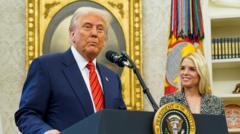In a groundbreaking move, President Trump and British Prime Minister Keir Starmer have finalized a major trade agreement that will notably reduce tariffs on key British goods, signaling a strengthening of U.S.-UK trade relations.
Trump and Starmer Finalize Trade Agreement, Reducing Tariffs on Key British Exports

Trump and Starmer Finalize Trade Agreement, Reducing Tariffs on Key British Exports
U.S. and UK leaders cut tariffs on British cars, steel, and aerospace equipment, marking a significant step in trade relations.
In a much-anticipated announcement made during the Group of 7 summit in Canada, Trump confirmed that U.S. tariffs on British cars would be slashed from 25 percent to 10 percent. Additionally, the agreement includes provisions allowing for a specified volume of British steel and aluminum to enter the U.S. without tariffs. The deal is seen as a significant win for Britain, with both leaders expressing optimism about its potential impact.
Starmer called the agreement "really important" and marked the day as a significant milestone for British manufacturers, particularly in the aerospace sector, with lowered tariffs on airplane parts. The executive order reflects a successful negotiation effort, which Trump praised as coming after years of stalled discussions.
However, it remains to be clarified how many British steel products will be able to enter the U.S. tariff-free, as the Commerce Department still needs to determine a quota. Trump's previous tariffs on foreign steel had reached 50 percent, creating a complex backdrop for this new deal.
As discussions continue to unfold, both leaders aim to enhance trade flows between their nations amidst a dynamic global economy. The agreement is expected to be monitored closely by industry officials and economists, eager to assess its long-term impacts.
Starmer called the agreement "really important" and marked the day as a significant milestone for British manufacturers, particularly in the aerospace sector, with lowered tariffs on airplane parts. The executive order reflects a successful negotiation effort, which Trump praised as coming after years of stalled discussions.
However, it remains to be clarified how many British steel products will be able to enter the U.S. tariff-free, as the Commerce Department still needs to determine a quota. Trump's previous tariffs on foreign steel had reached 50 percent, creating a complex backdrop for this new deal.
As discussions continue to unfold, both leaders aim to enhance trade flows between their nations amidst a dynamic global economy. The agreement is expected to be monitored closely by industry officials and economists, eager to assess its long-term impacts.




















